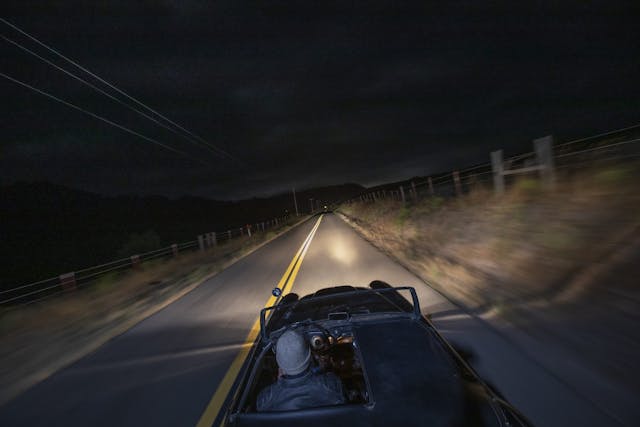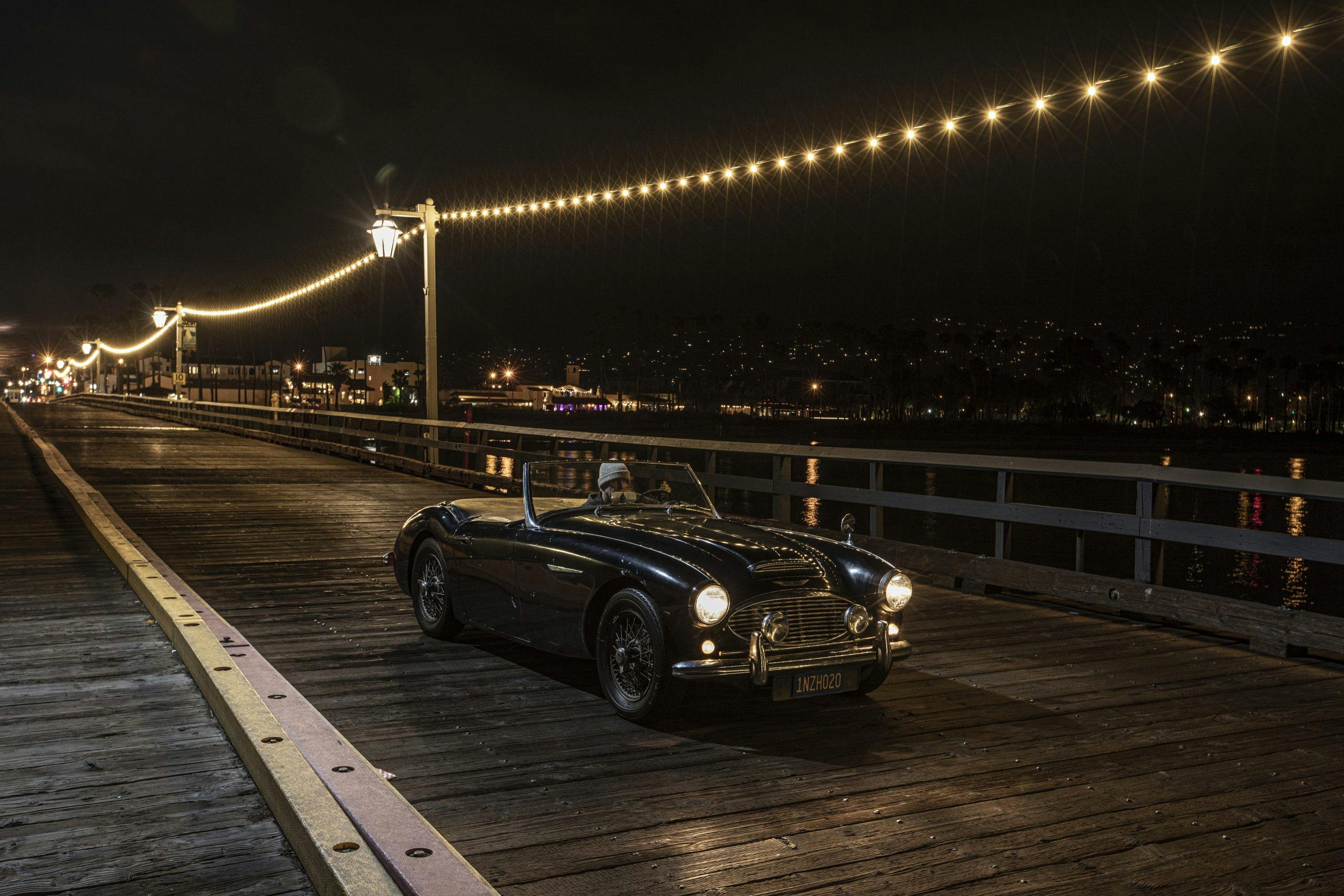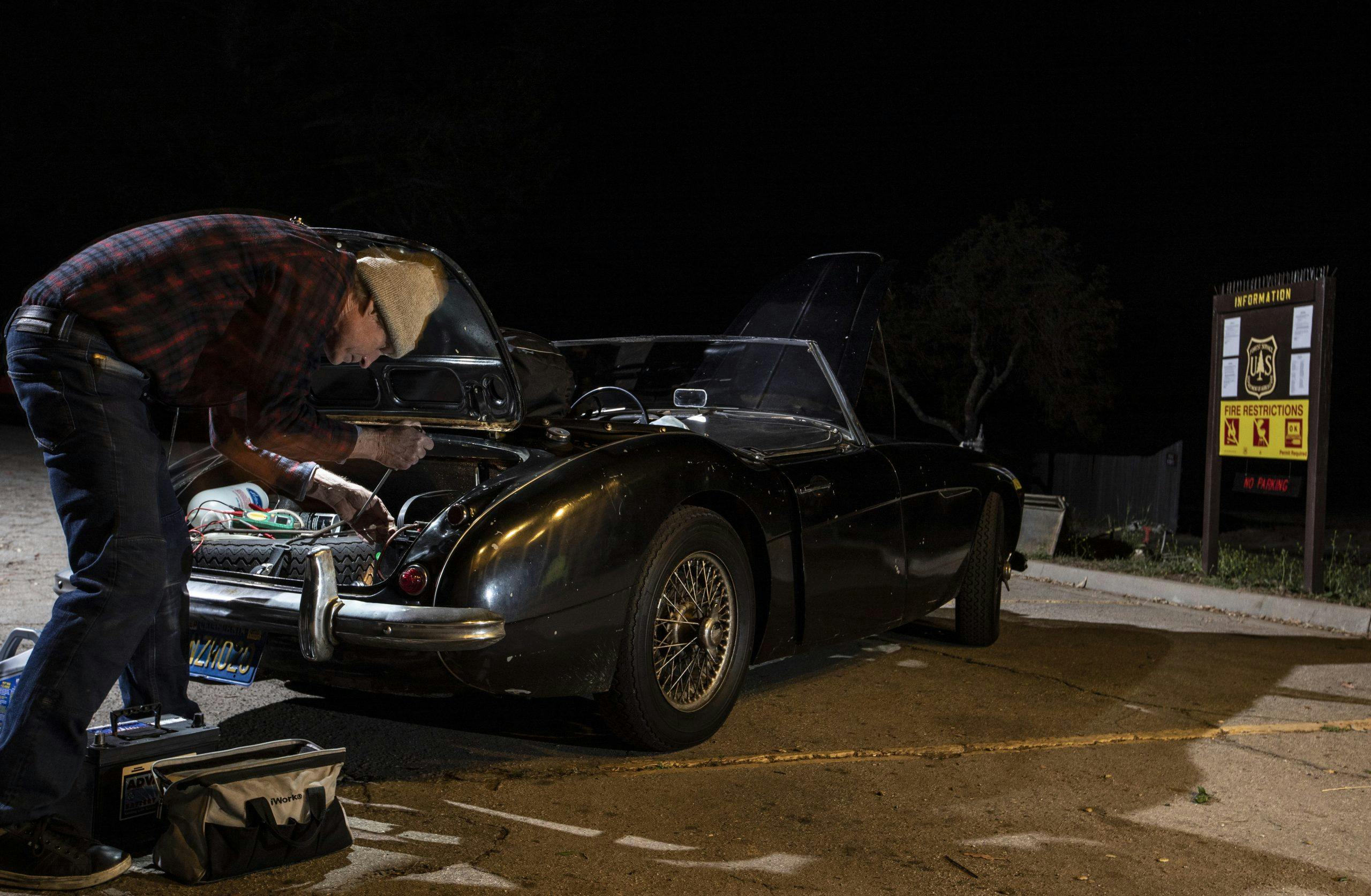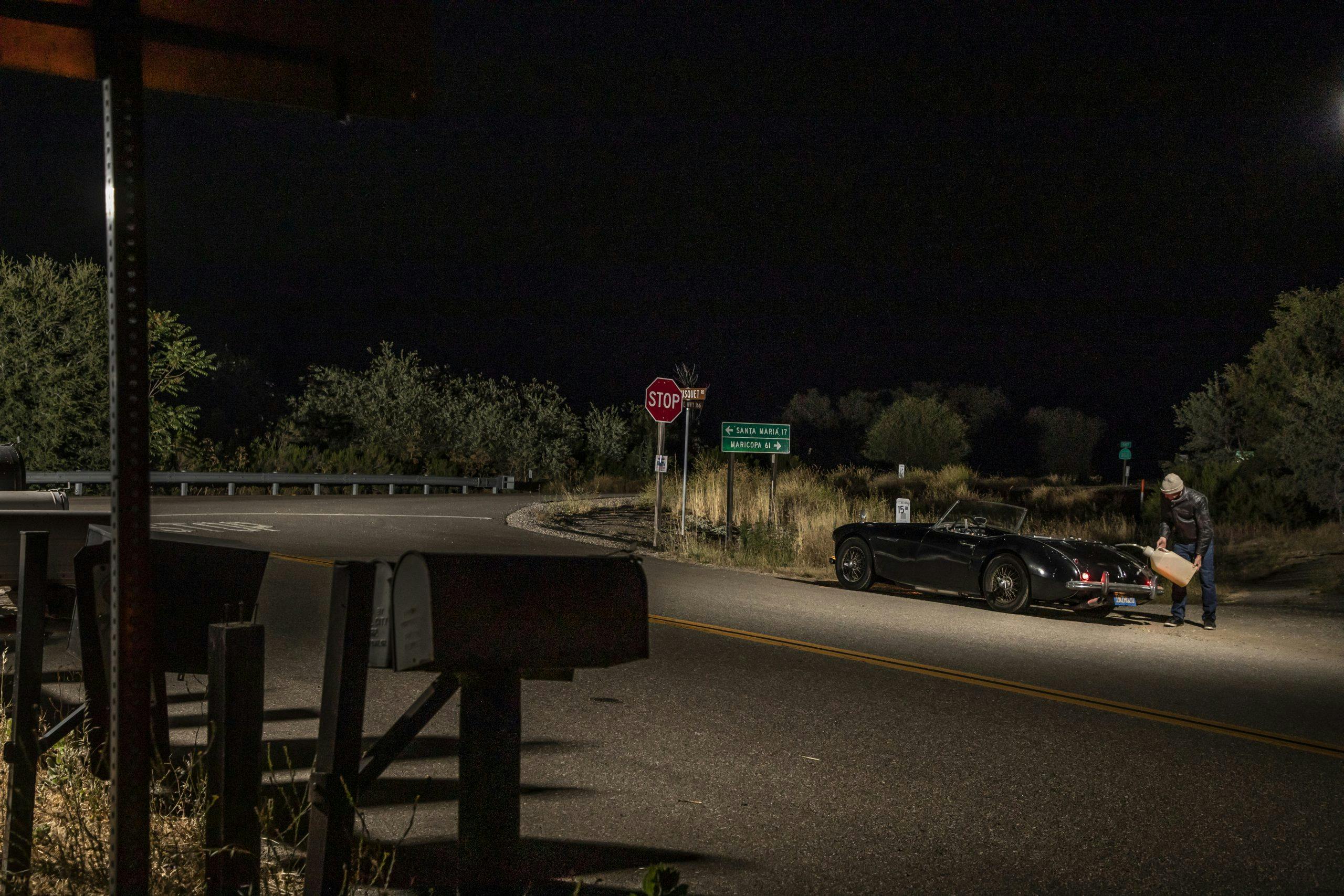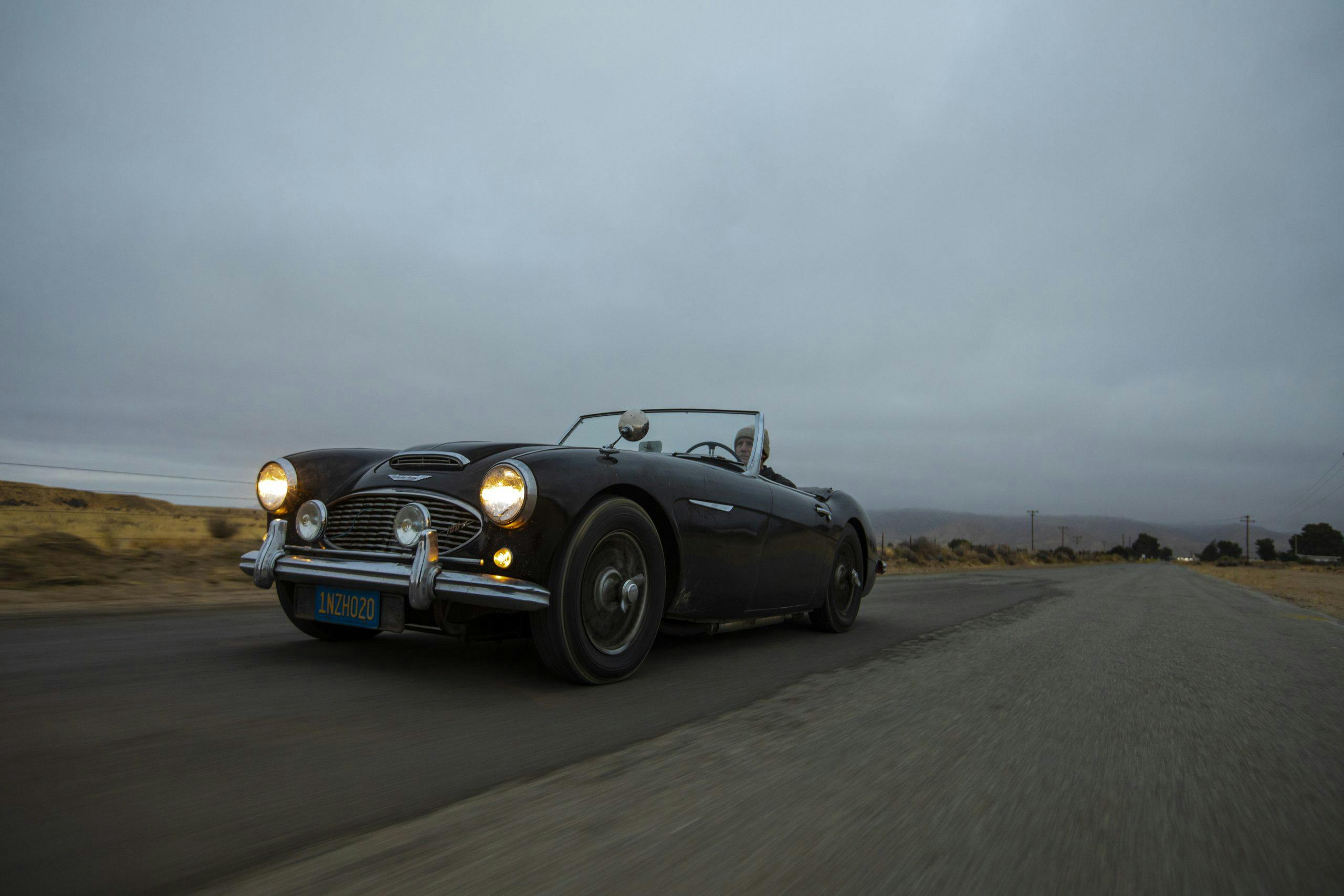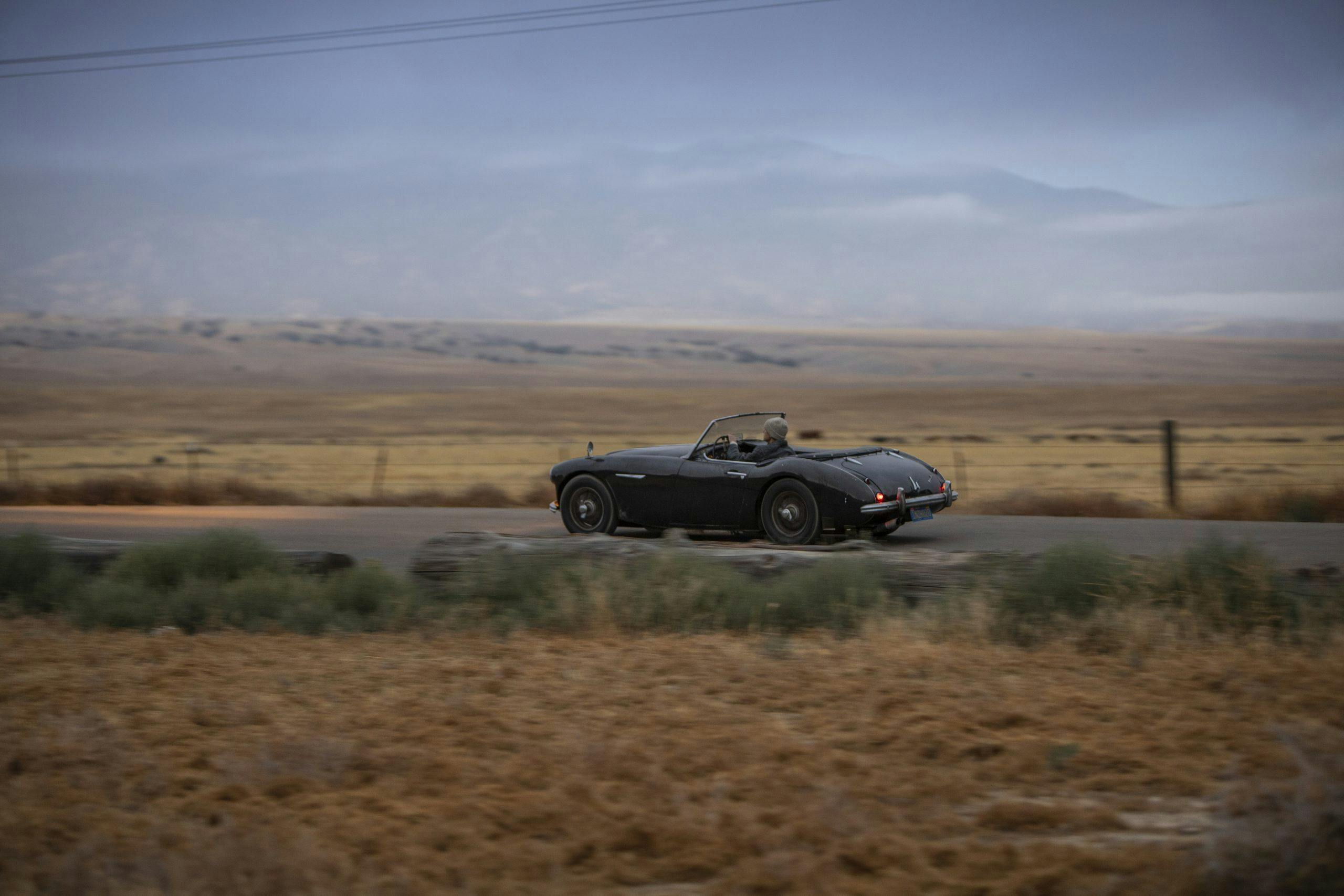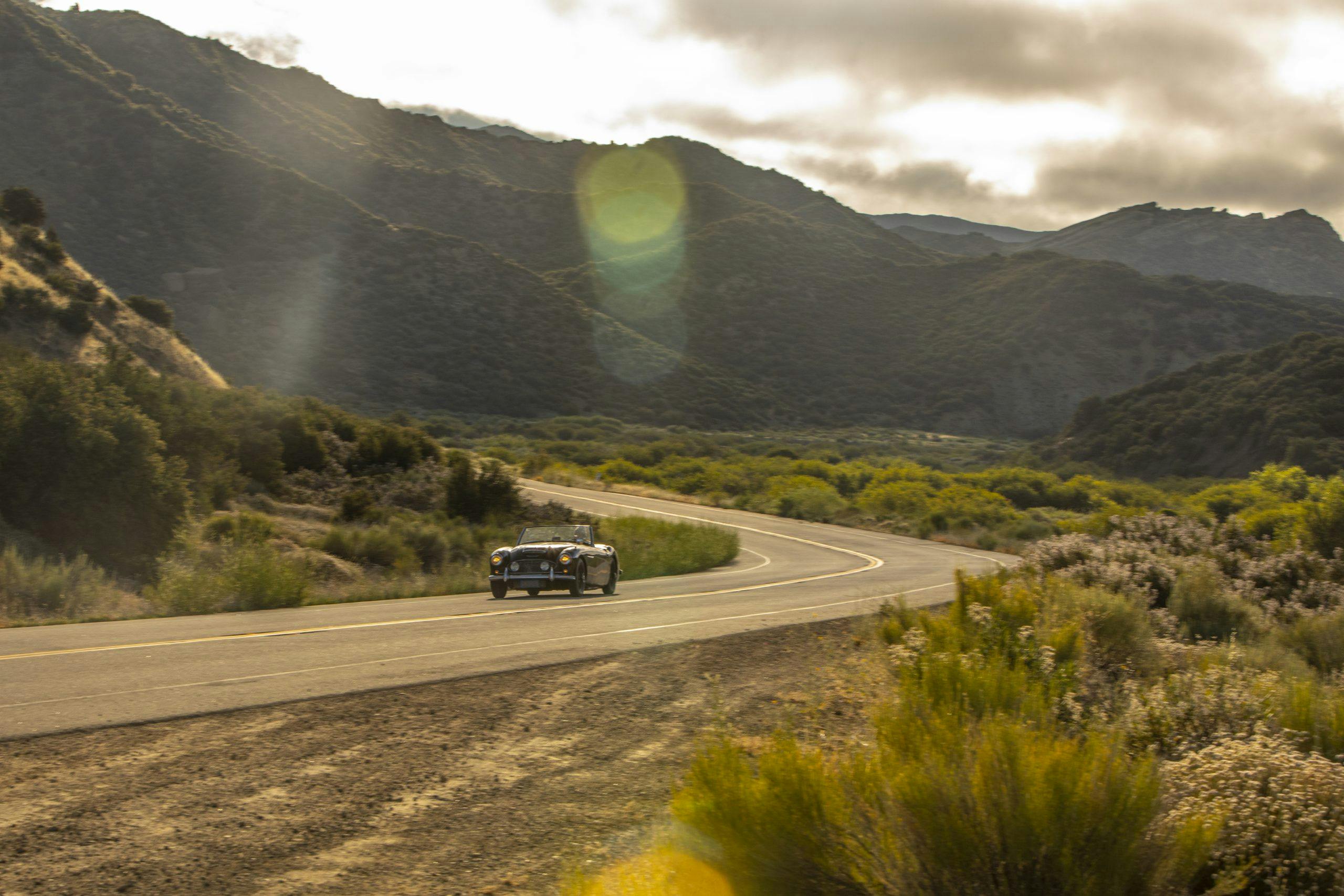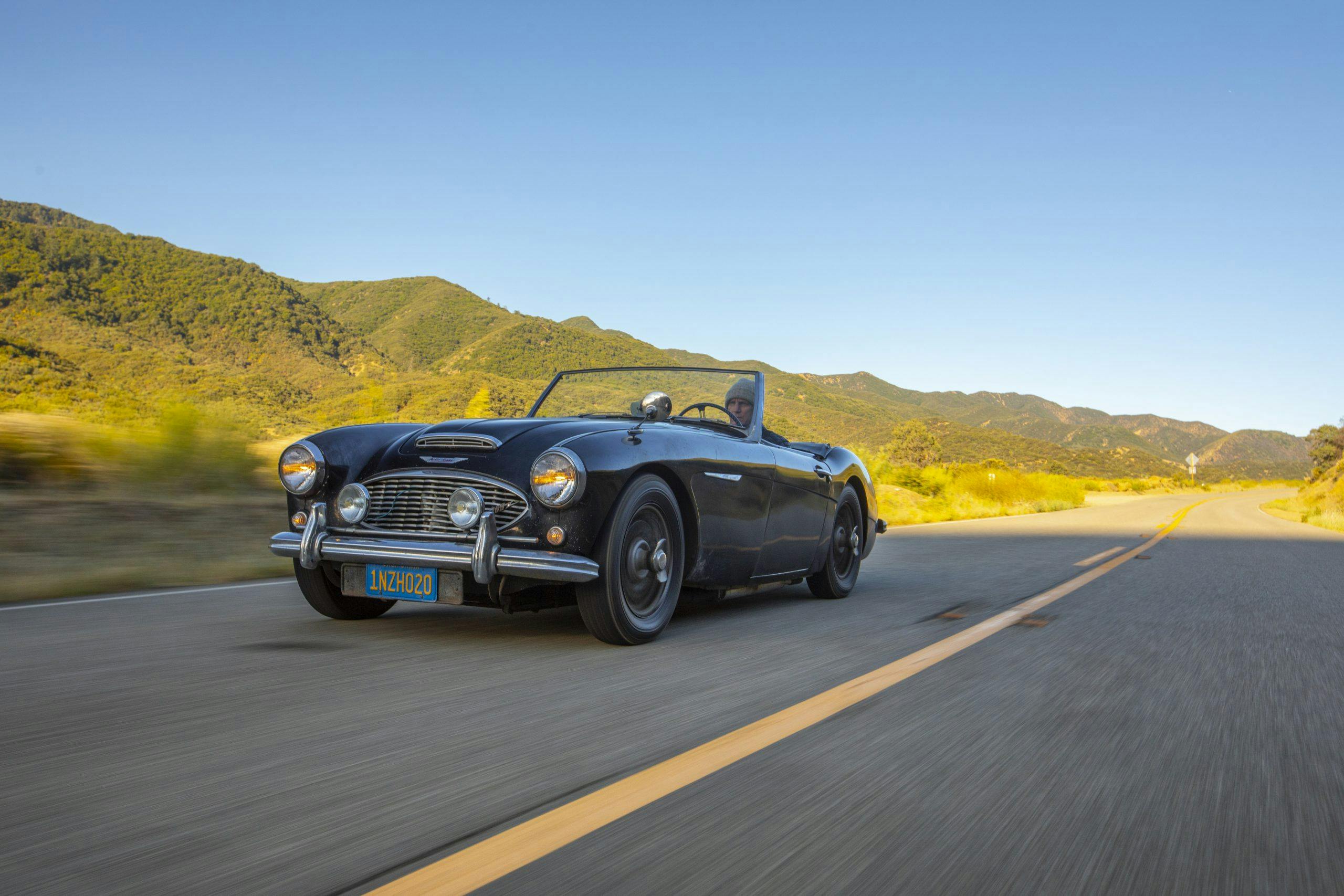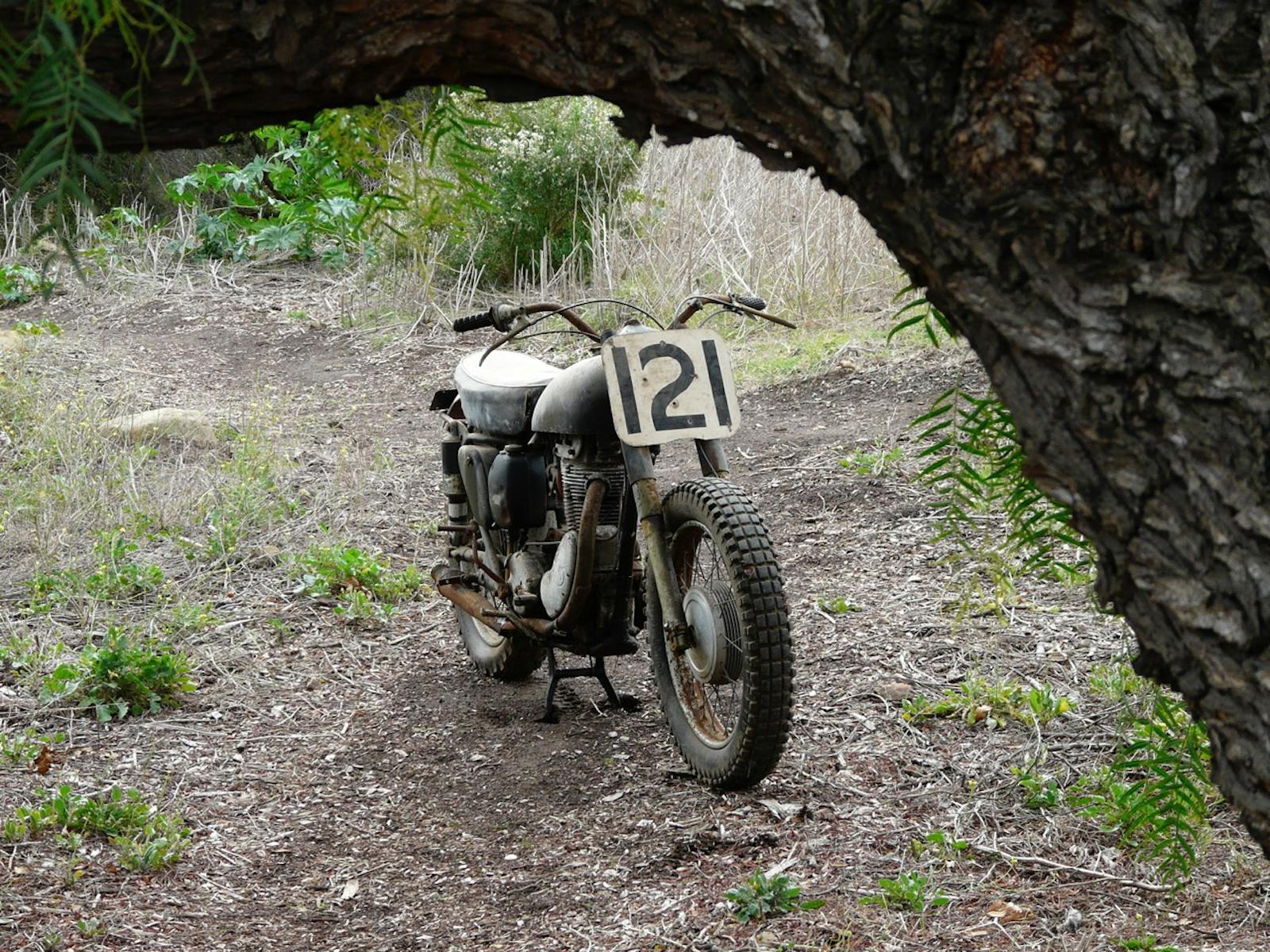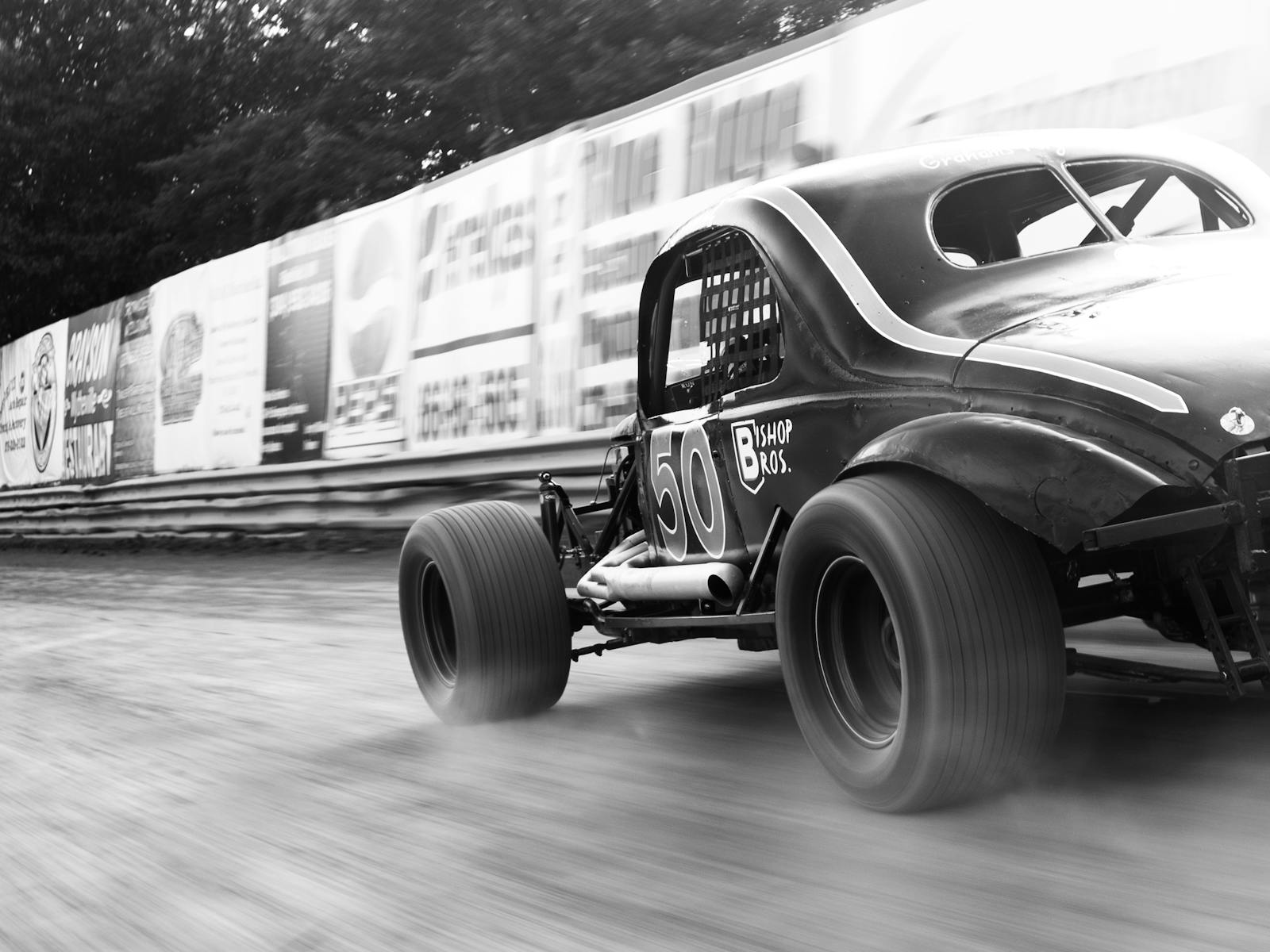Undisturbed for 29 years, this Healey took us on an all-nighter
At 2:30 a.m., miles from anywhere on a black night in a black Austin-Healey on a black highway with the dark ghost of Joseph Lucas hovering above me like a Harry Potter Dementor, everything looks like an animal. The branches of the valley oaks rushing by overhead, roadside grasses rustling in the breeze, and fence posts streaking past the doorsills all connote images of animals in motion. I felt like a Pliocene man gaping at the constellations and concluding they are actually animal spirits. Suddenly, the surreal turned real as a young white-tailed buck vaulted across the road, mere feet in front of the Healey, its rusty coat and brown eyes the size of demitasse cups, frozen for a dangerous moment in the searing beams of the Marchal driving lights. I slammed hard on the brakes; the pedal pushed eight Ferodo linings against the iron drums, and, mercifully, the 100-6 slowed. Collision averted, but it got me thinking: What am I doing here?
It is a fair question. Weeks after embarking on this bizarre all-night mountain drive in a survivor Austin-Healey 100-6, I’m still grappling with it. Sure, George Mallory famously quipped that Everest needed climbing “because it’s there.” But that’s too simplistic in this case—and anyway, Mallory’s reply was probably meant to dismiss idiot reporters who all wanted to know why. Maybe he really didn’t know, any more than I know why I just almost hit a deer when I could be happily asleep in my own bed.
I love my hometown on the central California coast, with its immediate adjacency to coastal mountains and flowing two-lane roads. Over the years, I’ve ridden and driven them so often that they almost feel like part of my soul. And yet, and yet … like a marriage, or a weekly menu, or a job routine, or a music playlist, sometimes even things we love begin to feel old. Too familiar. No longer fresh or invigorating.
We can no more invent new roads than cast new planets, so what to do? Maybe upend the clock and drive them at night instead of by day. The added dose of uncertainty, danger, and discomfort nighttime brings can make taking a vintage car highly rewarding in the event of success. And hugely unpleasant in case of failure. En garde!
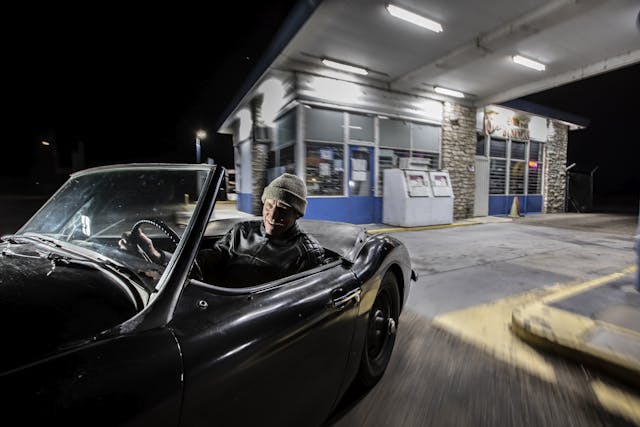
This garage-find Healey was the call. An amateur rally car in the early 1960s, it was outfitted with aircraft lap belts, the aforementioned driving lights, and a Koni tube-shock conversion up front. It was a well-used old dear when its owner shoved it inside a garage three decades ago and left it to molder. After buying it, I methodically serviced all systems (electrical, fuel, cooling, brakes, chassis, tires, and clutch) one by one, returning it to fully useful—albeit cosmetically tatty—status.
So, one Saturday night, instead of hitting the hay, I brewed a thermos of coffee, threw some snacks, tools, a flashlight, and gloves into a bag, opened the garage door, and approached the Healey. Trunk opened, I turned the master switch and then hopped into the low bucket seat, put the gearbox in neutral, pulled the choke knob for the twin SUs, turned the key, and pushed the starter button. The 2.6-liter six shook to life and settled into a smooth idle, the metal air filters sucking in cool, dense evening air. Engaging the synchronized second gear before non-synchro reverse stopped the gearbox’s input shaft, which made grabbing reverse gear chatter-free. I engaged the clutch, and the Healey backed into the street, angled south, and headed toward the Pacific Ocean and Santa Barbara, to California’s historic Stearns Wharf. I had envisioned starting on the pier and finishing there with a quiet breakfast the next morning. In reality, though, jouncing slowly over the hundreds of treated wood beams that make up the pier’s surface, swinging a 180, and steeling myself to go proved more worrisome than exciting. It was zero hour—midnight.
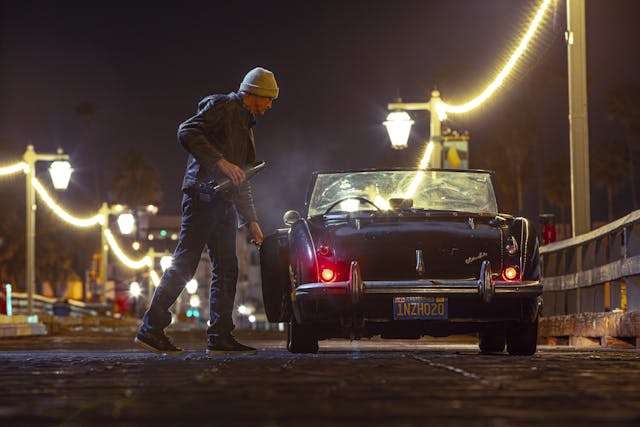
As I motored up State Street toward the Santa Barbara Mission, the setting moon revealed La Cumbre Peak to the north, skirted with clouds. It was going to get real dark, real soon. The last bit of city light vanished as the Healey passed the Mission and turned onto winding Mountain Drive. Bulwarked by a hewn sandstone wall on the right and ancient oaks on the left, the road looked ethereal, mystical, and tunnel-like as the Healey’s headlights swept between the rocks and tree branches. A fun little bit of chicanery by day, by night, even these first few miles of my 220-mile loop took on an almost fictional quality—like a scene from Tolkien’s The Lord of the Rings.
The Healey hummed along in third gear, water temperature at 180, gas gauge pegged, oil pump pushing 40 psi of high-zinc 20W-50 through the old galleys. A curious thing about Big Healeys is that occupants can be at once hot and cold. The driver’s footwell is beside the engine block and behind the exhaust headers, and the seat is directly above the muffler. This cocoon is like a pizza oven with a broken thermostat, and it became ever hotter as my drive progressed, especially uphill. And by uphill, I mean really uphill. Over 10 miles, the route climbed nearly 4000 feet. Halfway up, the Healey plowed into the mist, which made visibility difficult with the standard headlights. I switched on the Marchals for help, although the extra firepower scattered through the cloud droplets, ruining clarity of vision. But they were utterly necessary to negotiate this writhing road at anything more than a crawl. The turns are so sharp, the night was so dark, the drop-offs so steep and the visibility so poor, the first navigational misstep could also have been the last.
High up the mountain, hidden in the inky night, were pockets of parked cars. They were either stargazing or partying, and I suspected the latter. As I passed one group, the faint smell of banana bread wafted into the Healey cockpit. “That’s odd,” I thought. “Banana bread on a mountain road in the middle of the night?” I expected a different smell, but I carried on, out of the cloud bank and onto a ridge top that led toward the Santa Ynez Valley wine country.
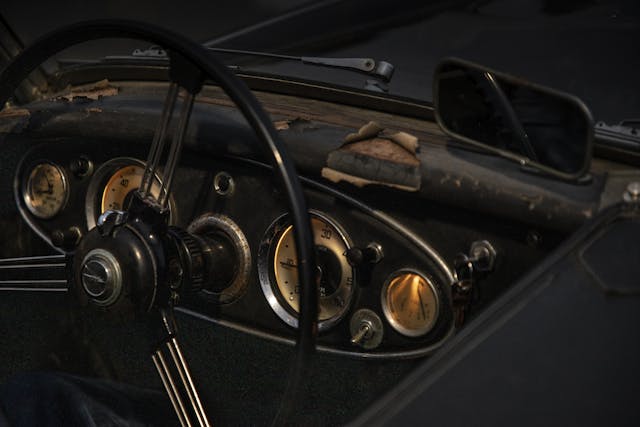
Soon, the charge light in the Healey’s tachometer illuminated, meaning the charging system had faulted. Why, I don’t know. I carried on along the ridge top and down toward the Santa Ynez Valley for 10 or so miles. Even with the driving lights off to save juice, the main headlights lost their accuracy—so much so that seeing anything in the road became hard. With centerlines, roadside markers, and reflective aids nearly nonexistent here, it was clear that only partway through this trip, things were getting dicey. I stopped at a closed ranger station, thankful for its floodlit lot.
Good thing I brought tools. A battery check showed 12.4 volts with the engine running, not the desired 13-plus volts, and revving the engine didn’t build voltage as it should. This suggested either a generator or regulator failure, and it proved to be the cheap re-pop regulator. Pulling off the cover showed one set of points askew, and the unit—aha!—smelled like banana bread. So that was it! I can’t prove it, but I strongly suspect running the Marchal lights through the clouds overworked the regulator, which couldn’t handle the load. Fortunately, in the trunk was a spare NOS Lucas unit, which I installed by flashlight and feel. It just takes a screwdriver—simple.
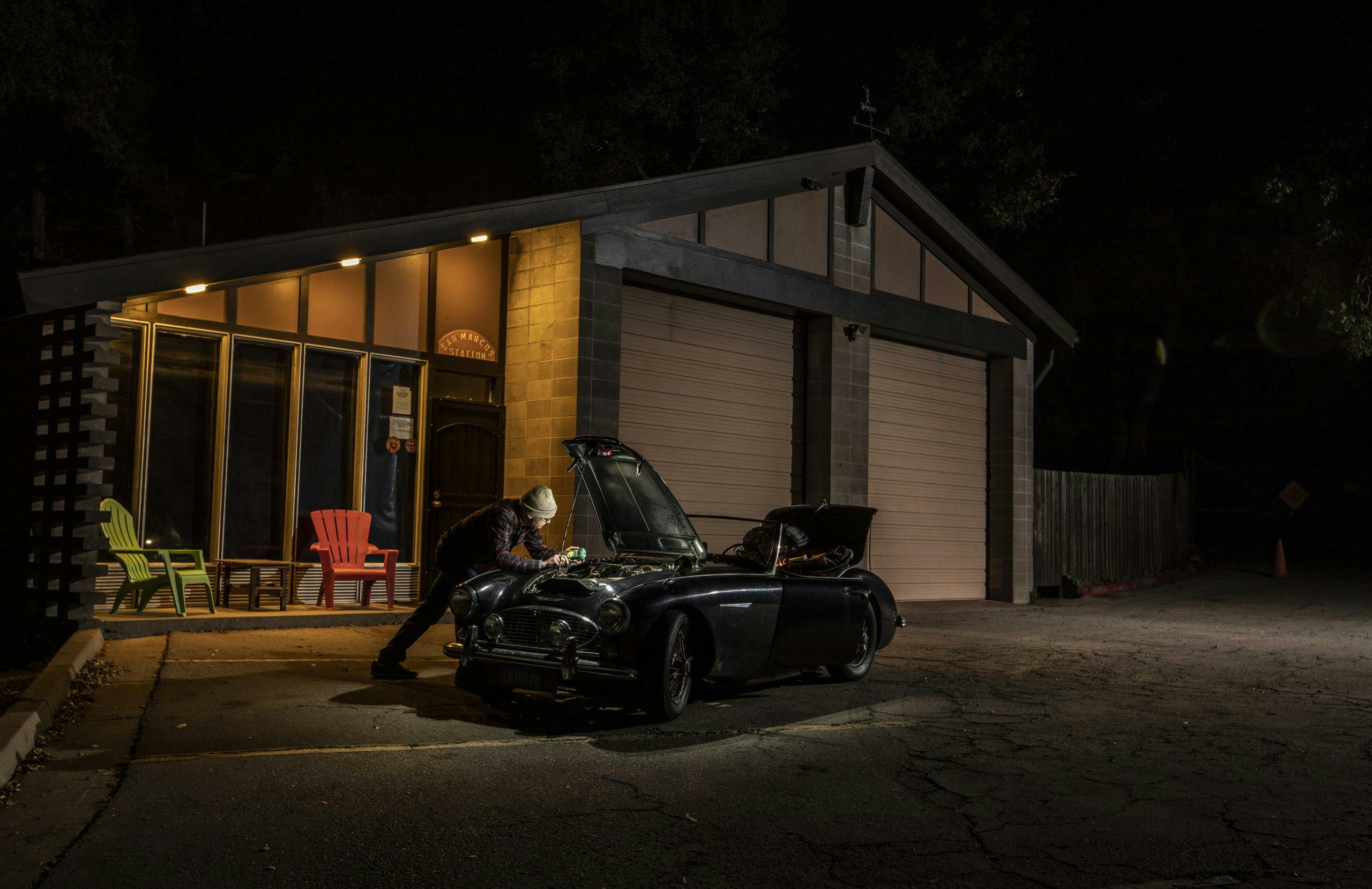
It was nearly 2 a.m. when I reached a 24-hour gas station in the Santa Ynez Valley. The oil level was fine, the bugs and mist got cleared from the windshield with some Rain-X and paper towels, and the Big Healey was fueled and good to go.
I’m no Meriwether Lewis or William Clark, but I can imagine the excitement these explorers must’ve felt after crossing the Rockies to enter the West. As the Healey burbled through Santa Ynez and bucolic Los Olivos, then turned north on Foxen Canyon Road into wine country, it felt as if it were similarly breaking free. The environment agreed. Heading north, I was instantly enveloped in one complex rush by the invigorating sensual nature of open motoring. The roadside grasses, lightly painted with dew, emitted a marvelous pungency. The steady drone of the iron six breathing through its twin carbs and exhausts was as reassuring as the Wright Whirlwind radial engine that pulled Lindbergh’s Spirit of St. Louis across the Atlantic.
The Marchal driving lights, low mounted as they are, illuminated fine details of the macadam aggregate, as well as details far ahead. The Girling lever-arm rear shocks sent every road ripple, bump, and dip through the seat base and into my spine. The reproduction Michelins telegraphed surprisingly precise road feel through the timeworn steering.
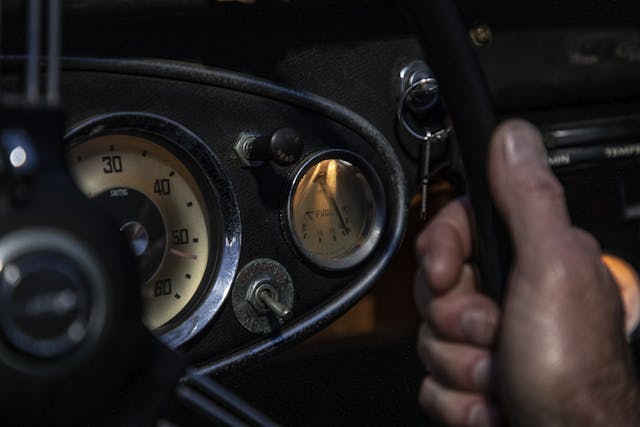
Over the decades, I’ve traveled this route numerous times by day, but never at night. It’s disorienting, as darkness messes with perception. The many small landmarks so easily recognized by day are easily missed at night, and as a result, that sense of knowing where I am was largely absent. That is, unless these landmarks are unique: a deep drainage swale; a left-right dogleg bisecting two farms; an old windmill. I made a hard right onto Tepusquet Road, where the Healey engine droned loudly on overrun, like Lance Macklin’s Healey 100S braking for the Mulsanne Corner at Le Mans. All appeared suddenly in the 100-6’s four headlights, like visages in a runaway dream sequence I couldn’t control.
Tepusquet is animal country. Joining Santa Ynez Valley and the Cuyama Valley, the road was created the old-fashioned way, by following contour lines within the canyon. Its remote location, dense foliage, and water in low-lying areas are ripe for native fauna, none of which could possibly be expecting a black Austin-Healey on a black night to infiltrate their space. This included the buck and, farther along, a pair of barn owls, swooping between oaks and low over the road. It also included mice, a coyote pup, and a bobcat, startled by the headlights and running ahead of the Healey on the narrow road. I brake for bobcats! They’re native to central California, but I’d never seen one until tonight. It broke hard right into the brush and was gone.
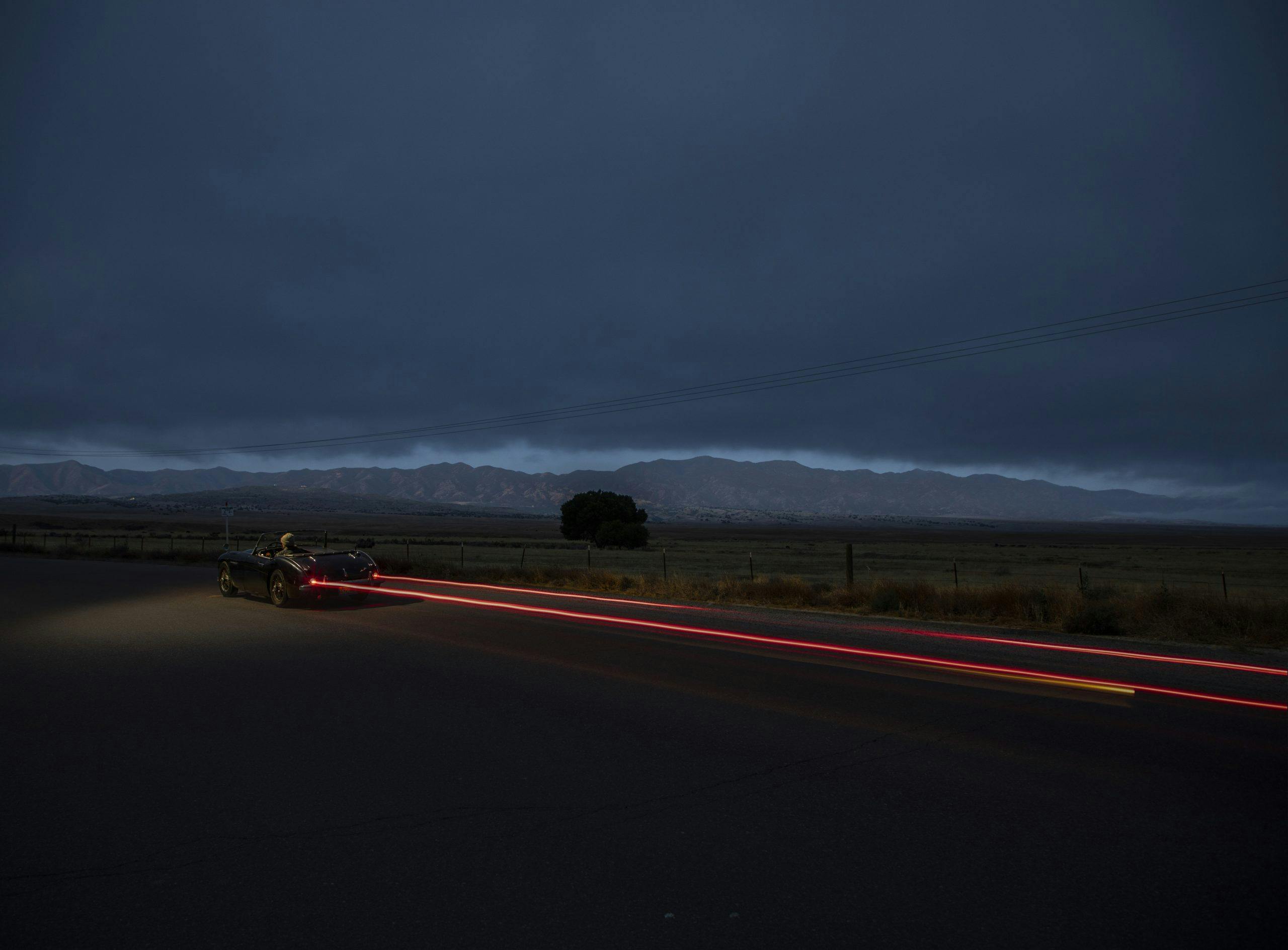
It was probably 3 a.m. by now, maybe later. But the Healey doesn’t have a clock, and I didn’t bother to check my phone. Who cares, anyway? That’s the beauty of being out all night. It’s your train and your train schedule. The roadster hummed onward, and downward, through Tepusquet Canyon. Here the walls seemed to close in, and it got steeper and creepier as the oaks reached even more menacingly over the road.
“It’s hard to leave when you can’t find the door,” sang Joe Walsh. Well, the same might be said for corner apexes when you can’t see the exits. There’s a section of Tepusquet Road that winds down and around, and around and down, like a series of Laguna Seca corkscrews. The Healey’s balky steering, rife with friction, and its simple suspension made this a mental and physical workout. A prang here would have involved a centuries-old immovable oak.
This was getting to be incredible, as every corner brought new criteria to interpret, manage, and then leave in the mirrors. It happens quickly in the dark; if you’re jumpy, a nighttime drive like this might make you jumpier. But it will also improve you.
Something loomed ahead that was Not Good. It was a sign, both literal and figurative. It said, “Road Closed 10 Miles Ahead.” I was miles and hours into this route, and it was now seriously late at night. I drove on, figuring that it was a daytime warning—but true to the signage, more serious-looking “Road Closed” signs and concrete barriers appeared on cue. Full stop.

So, what to do? Tire tracks on the dirt shoulder indicated vehicles had bypassed the blockade. That was promising, but if rough road lay ahead, the Healey and its 5 inches of ground clearance would not an adroit Mars rover make. I shut down, zipped my jacket closed, grasped the flashlight, and walked ahead.
Every minute in the pitch black at the bottom of this remote canyon felt like an hour. The dark-adapted eye is a pretty good tool, especially peripherally. Ears are OK, too, if they’re not ringing like mine were. The nose—well, we’re not bloodhounds, are we? So, while padding along in the night, I was keen to sense what was in the woods. My mind raced through possibilities, such as mountain lions, boars, black bears—even Jack the Ripper. Nearest I could tell, though, there was actually nothing happening—not so much as the creak of a twig or rustle of a leaf, not a yip nor a growl nor a trill from any animal. And no fiery pagan rituals.
But there was indeed a washout, around which ran a rudimentary one-lane bypass that looked plausibly navigable. I returned to the Healey, restarted it, and bounced my way past the washout, eventually rejoining solid asphalt. As low as they were, the Big Healey 3000s similarly got it done at the Alpine Rally in 1961 and 1962—albeit with skid plates.
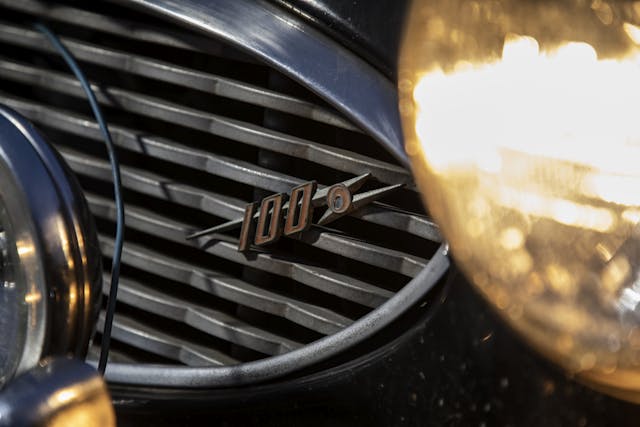
Having committed my crime, I covered the last few miles of Tepusquet Road until it intersected State Route 166, linking coastal Santa Maria with the famous Grapevine. As in, the Grapevine in the song “Hot Rod Lincoln:” “We was drivin’ up Grapevine Hill/Passing cars like they was standing still.” Turning right there, the 100-6 and I settled into a boring 36 miles through the darkness to little New Cuyama, population 517. Flipping the dash-mounted overdrive switch dropped the revs to 2700, and the Healey booked along happily at 60 mph. The wind was really loud, it was a beautiful night and it was fairly chilly in the airflow, but my feet were roasting below decks.
Four o’clock in the frigging morning, here was the tumbleweed town. Thankfully, the old gas station, though dingy and windblown, features 24-hour self-service. A tank of premium and a quick calculation showed that the Healey’s fuel economy improved to 17 mpg on the run through wine country, down the long canyon and along the State Route 166 corridor. That’s more like it. And then, was it my ringing ears, or were distant roosters crowing? With the dark eastern hills silhouetted against the faintest hint of gray sky, dawn was on its way and the roosters’ walnut brains knew it before mine did. Monday would welcome me not with coffee and eggs Benedict on Stearns Wharf but with hunger pangs in Cuyama Valley.
It is astounding how fast the night flew by. It seemed like only moments ago that I made my start above the lapping Pacific waves, and now it was nearly dawn in this remote valley. But weirdly, I wasn’t tired; maybe my own rooster brain was activating for the new day.
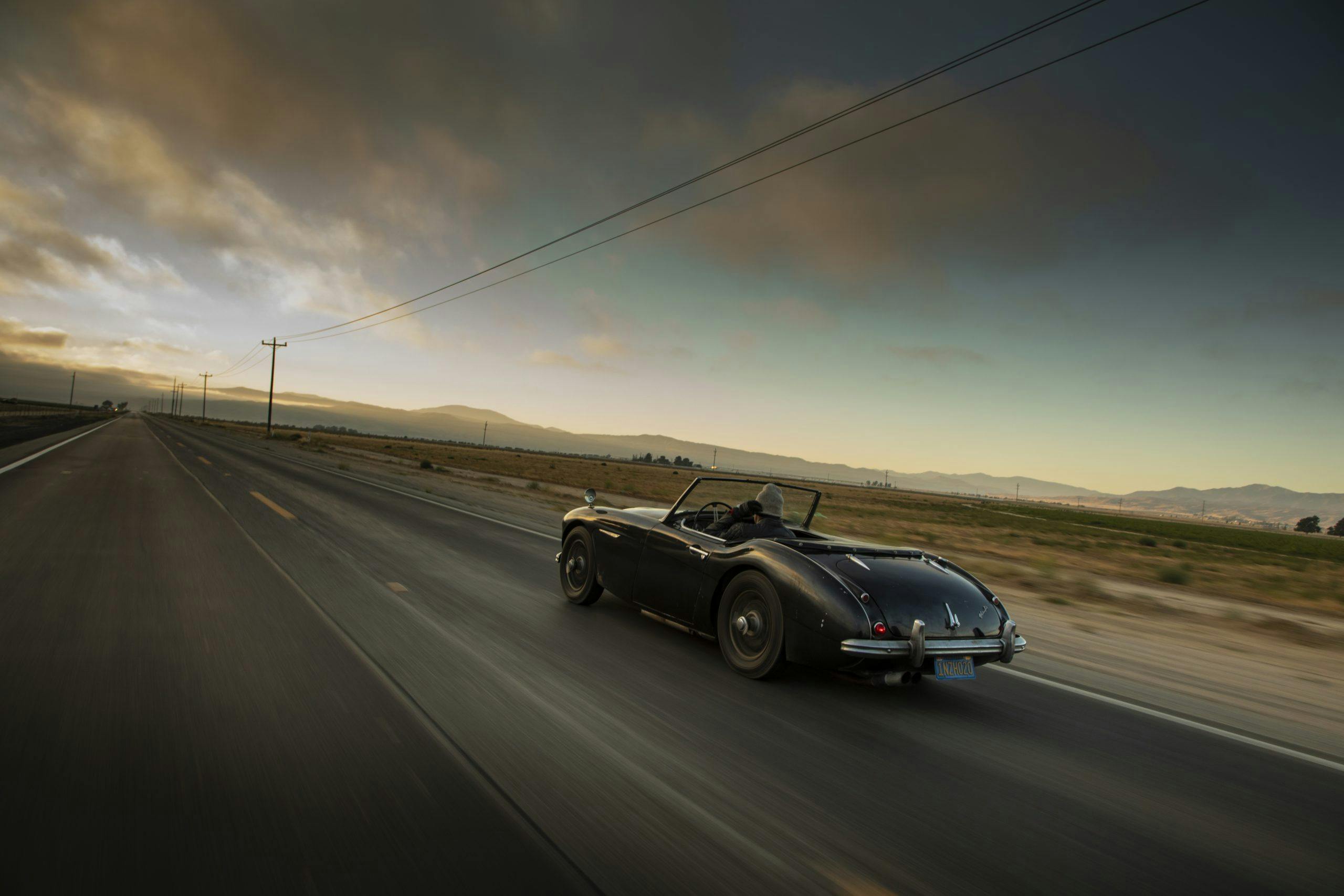
Tank filled, tires and oil checked, the Healey rejoined State Route 166, again heading east. It was almost light enough to see now, and the engine thrummed along faithfully, its overdrive alive, the oil pressure and water temps feeling fine. All was right in this Big Healey’s world. At least, until the sun finally peeked above the peaks, and the pastel sky brought not warmth but more biting cold. Now, not even the boiling footwell inside the Healey could blast enough BTUs to keep my upper body warm. I was wearing heavy jeans, a T-shirt under a flannel shirt, a leather jacket, motorcycle gloves, and a beanie, but I was still bloody cold.
A final challenge loomed ahead—the north side of the Transverse Ranges separating bleak Cuyama Valley from artsy Ojai. It would be 5 steep miles up and over 5160-foot Pine Mountain Summit before I could rejoice in a relaxing 30-mile descent into Ojai, then 18 more miles downhill to Ventura and the Pacific. It promised to be a lovely finish—if the Healey and I could make the grade. Rated at 102–117 horsepower when new, the 100-6 was hardly a performance darling in period, and years and miles have surely dropped this example’s vigor further. As a result, third gear, with overdrive off, was the right choice for scaling this last topographical test.
This is a short odyssey, I’ll admit, compared to the 24 Heures du Mans or the Baja 1000. Yet, overnight in the black bucket seat of a black Healey through the black of night feels pretty defiant, as the 9-to-5 world goes. In the end, the lazy glide path back into daytime, and the leisurely coast down to the ocean, felt very much like rejoining a world left behind. When I intersected Highway 101, it was all still there, with the morning commuters, surfers, and shorebirds barely giving the Healey a glance. Why should they? It was just a dirty old car parked at the beach, with its driver gazing vacantly offshore, looking for answers.
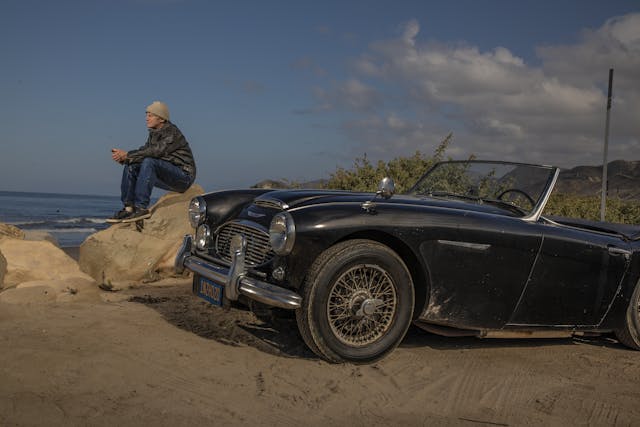
So, what’s this all mean, anyway? Sadly, no apparitions appeared above the waves to let me know. But I can offer this: Driving all night, even on well-known roads, will add new excitement to your classic-car routine. It’s like diving into a rabbit hole, exploring all that can possibly be sensed in the dark, then popping back into the sunlight, dazed, stunned, and yearning for meaning. Which, in my case, mainly includes wishing I’d brought along breakfast and a surfboard. How’s that for deep? Well, by this point, I had been up 26 hours and had an hour’s drive home ahead of me.
Driving alongside the Pacific in a dirt-streaked old Healey contrasting with the polished Priuses and Teslas of the workaday crowd is my kind of protest. Even so, I’ll admit, the world seemed welcoming instead of forbidding—and also bright, colorful, and fun. It’s no wonder we’re such creatures of daytime. But now, the night’s all right with me.
1958 Austin-Healey 100-6 BN4
Engine: I-6, 2639 cc
Power: 102 hp @ 4600 rpm
Torque: 141 lb-ft @ 2400 rpm
Weight: 2440 lb
Power to weight: 23.9 lb/hp
0-60 mph: 11.6 sec
Price when new: $3095
Hagerty #3-condition (Good) value: $44,500–$67,500
